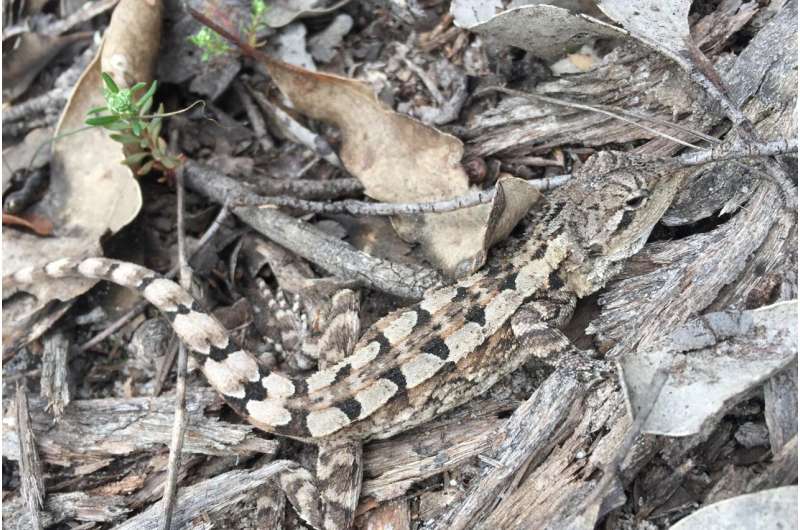This article has been reviewed according to Science X's editorial process and policies. Editors have highlighted the following attributes while ensuring the content's credibility:
fact-checked
trusted source
proofread
Reptiles are helping us better understand threats to Australia's biodiversity

It's an early morning in January and we're walking through a patch of native heathy woodland in southwest Victoria, a few kilometers west of the town of Casterton, known as the birthplace of the kelpie.
Due to some recent planned burning, the scattered eucalypts provide little shade, and we have arrived just in time to see the spectacular grasstrees in bloom, with their tall, spear-like flower spikes.
We're here to find out how burning and landscape modification impact one of the less-understood groups of at-risk Australian wildlife—our reptiles.
We kneel beside the first pitfall trap. Looking up at us is a jacky dragon, a small mottled gray lizard with a long tail and black-and-white patches running down its back.
My volunteer gently lifts the lizard out of the trap and releases it next to some bracken fern while I record its presence on the datasheet, and then we set off to check the next trap.
Australia is considered a global hotspot for reptiles, and the majority of our more than 1,100 species are found nowhere else in the world. Though they often receive less attention than birds and mammals, reptiles have evolved many unique traits that make them interesting subjects for understanding the effects of ecological processes—including fire.
Reptiles are ectotherms, which means their body temperature is regulated by the environment around them (called thermoregulation), so their habitat plays an important role in allowing them to perform daily activities like foraging and nesting.
For species like the jacky dragon, habitat temperature also plays a critical role in reproduction, as the sex of hatchlings is determined by the temperature of the eggs.
While fire plays an important role in creating diverse habitats, changing fire regimes driven by climate change and human activity are a major threat to many species, including lizards and snakes.
Understanding how reptiles respond to fire is challenging, however, not only because of their diversity and variety of habitat preferences, but also due to other interacting factors like habitat loss, introduced species and climate change.
In Australia, around 40% of our native forests have been cleared or modified since colonization. Habitat loss and modification are key threats to reptiles here and around the world, and most species now exist in habitats affected by activities including timber harvesting, agriculture, mining and urbanization.
In our new study, published in Forest Ecology and Management, we compared how reptiles responded to two potential threats—fire and landscape modification.
The heathy woodlands around Casterton were an ideal location as they are fire-prone and have a diverse fire history, meaning that some areas had been burnt within the last several years, while other areas had not experienced fire for decades.
These woodlands are also highly fragmented and what would have once been continuous native vegetation is now interspersed with pine and blue-gum plantation forests, as well as pasture.
We surveyed reptiles at 107 sites spread across about 320,000 hectares. Surveys were conducted by a team of six researchers and many generous, enthusiastic volunteers.
In total, we caught 1,208 individual reptiles covering 12 lizard species and four snake species. This included the endangered lined worm-lizard (a pale, earthworm-sized legless lizard with dark stripes) and the southeastern slider (a skink with a bright red tail and one of only a few species in the world where some populations give birth to live young and some lay eggs).
We looked at how these species respond to characteristics of their local environment that are both important to reptiles and influenced by fire—like the amounts of leaf litter, logs and canopy cover.
We also examined the effects of landscape structure—how much native vegetation, plantation, or pasture cover was in the nearby landscape.
Finally, we looked at whether their preferences for their local environment (including whether it was burnt or unburnt) could be influenced by the nearby landscape.
We found that some species strongly preferred open habitat with lots of light for basking, while other species preferred shady habitat.
Most reptiles, including the lined worm-lizards, preferred habitat surrounded by lots of native vegetation over habitat surrounded by plantation or pasture.
But our most interesting finding was that, for two lizards, the jacky dragon and White's skink, the nearby landscape influenced their habitat preferences.
For example, in native woodland areas without nearby pasture, jacky dragons preferred habitat that had been recently burnt. However, when their woodland home was surrounded by pasture, the dragons preferred unburnt habitat.
We're not sure what is driving these responses, but one potential answer may be how both fire and pasture impact thermoregulation.
In general, unburnt forest may be too cool and shady for jacky dragons, but recently burnt forest might provide them with just the right amount of light and heat needed to regulate their body temperatures and reproduce.
However, adding pasture to the landscape, which generally has few trees and little shade, may create landscapes that are too warm.
To our knowledge this is the first time that anyone has shown that the characteristics of the nearby landscape can influence reptiles' habitat preferences.
This has important implications for how we conserve biodiversity.
We may be able to support our unique reptiles by tailoring ecological fire management strategies according to the amounts of native vegetation, timber plantations or pasture in the surrounding landscape.
Our study also emphasizes the vital importance of maintaining our native vegetation to conserve these animals into the future.
More information: S.J. Mulhall et al, Do reptile responses to habitat structure and time since fire depend on landscape structure?, Forest Ecology and Management (2023). DOI: 10.1016/j.foreco.2023.121564
Provided by University of Melbourne




















